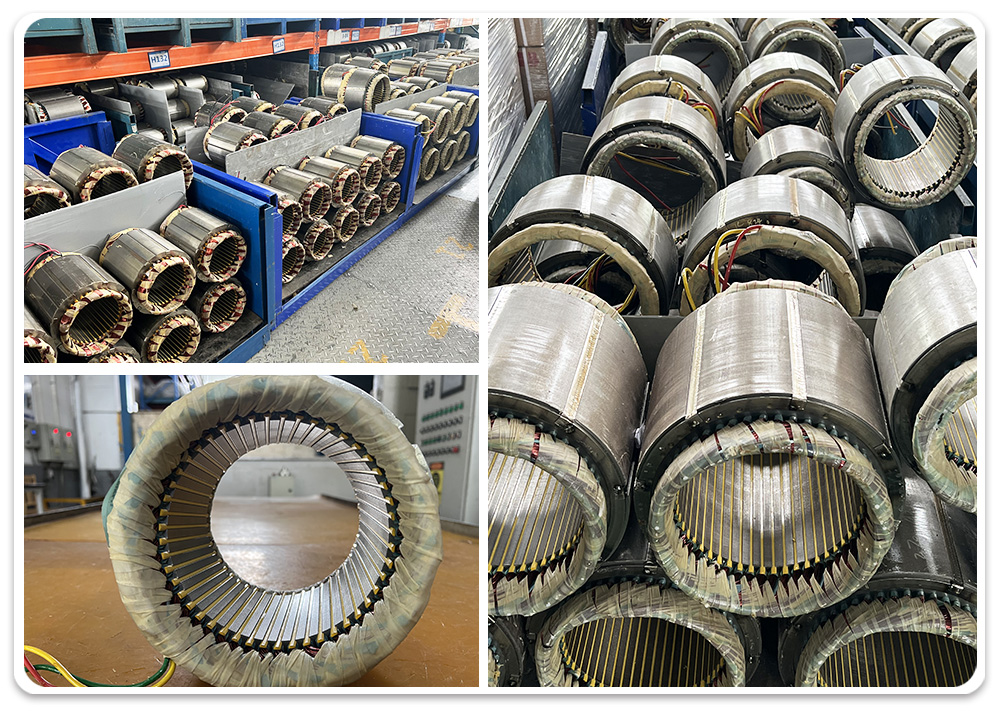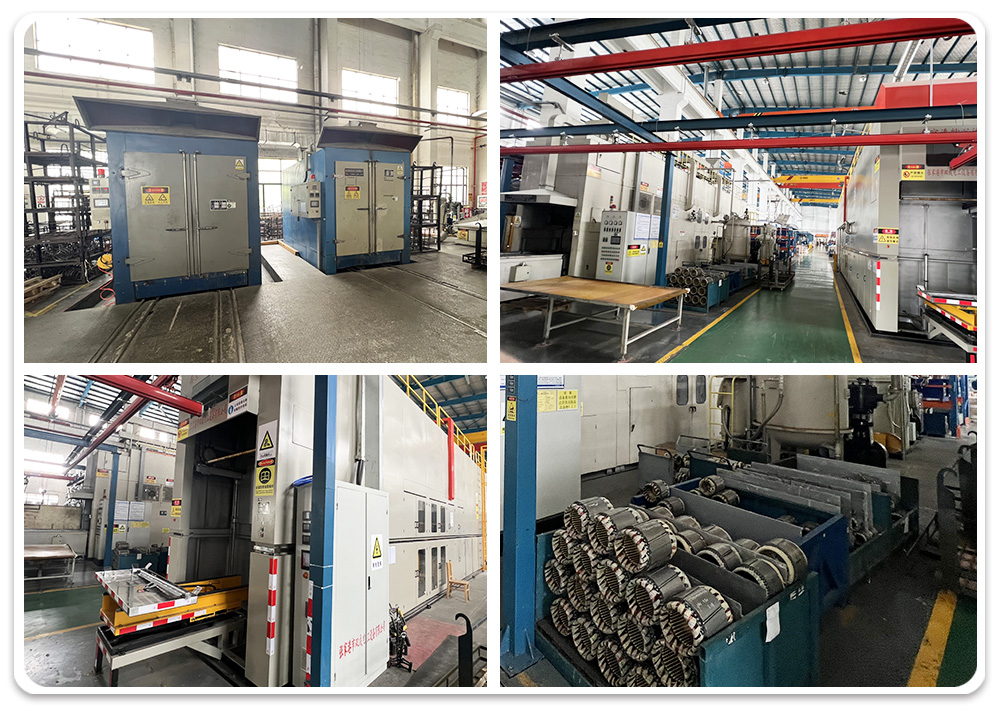Purpose of motor insulation treatment
Although the coil and other parts of the motor have certain insulation ability when they are made into stator and rotor, for example, the enameled wire is insulated by paint film as conductor; There is slot insulation in the iron core slot. However, the thin layer of paint film on the enamelled wire is very weak and vulnerable as the conductor insulation, and the enamelled wire, slot insulation and slot wedge move with each other. When the motor starts and stops, the insulating material shall withstand the impact of electromagnetic vibration and mechanical vibration, as well as the erosion of moisture, dust, salt mist in the air and corrosive gas or droplets in the working environment, as well as the aging of heating conditions during operation, In order for the motor to work normally under this condition, the coil and its adjacent parts must be impregnated with insulating paint, so that the insulated parts such as conductor and slot insulation are encapsulated into a dense and solid whole with insulating resin.

From the investigation of motor users, it is concluded that the most faults of motor in use are winding breakdown, winding short circuit, winding open circuit, winding burnout, etc., which belong to motor insulation problems. The service life of the motor mainly depends on the insulation quality, and the insulation quality of the motor is not only related to the insulation structure of the motor, but also related to the insulation treatment of the motor. The insulation structure is a design problem, and the insulation treatment is a manufacturing process problem. Therefore, in order to ensure the long-term reliable operation of the motor, once the insulation structure is designed and finalized, the insulation treatment is a key link in the motor manufacturing.
The following purposes can be achieved through insulation treatment:
(1) Improve moisture resistance
The insulation will absorb moisture to varying degrees in the humid air, resulting in the deterioration of insulation performance. After the insulation is impregnated, dried and cured, the air gap in the winding can be filled and a smooth and dense paint film can be formed on the surface, which can improve the ability to prevent the invasion of moisture and other media.
(2) Slow down the aging degree and improve the thermal conductivity and heat dissipation effect of the winding
Because the paint film formed on the surface of the insulating structure makes it difficult for oxygen and moisture in the air to immerse into the interior of the insulation, it can delay the aging degree and prolong the service life of the insulating structure. The thermal conductivity of insulating paint is about 5 times that of air. Filling the air gap with insulating paint can improve the thermal conductivity of insulating structure and heat dissipation effect.
(3) Improve electrical and mechanical properties
The insulation strength and other electrical properties of insulating paint are much higher than those of air. After insulation treatment, the winding is bonded into a whole, which not only improves the electrical properties of the winding, but also avoids the insulation loosening and wear caused by electromagnetic force, vibration and cold and hot expansion.
(4) Improve chemical stability
After insulation treatment, the paint film can prevent the insulation material from directly contacting with harmful chemical media and damaging the insulation performance. After special insulation treatment, the winding insulation can also have the ability of anti mildew, anti corona, anti oil stain and so on.
In general, the insulation treatment of motor winding is conducive to prolong the service life of the motor and improve the mechanical and electrical performance of the motor. The quality of paint dipping insulation treatment of motor stator is directly related to the quality of the motor. Therefore, the motor manufacturers take paint dipping insulation treatment as a special key process, and the production process is controlled in real time to ensure the paint dipping quality.

Common problems and solutions of motor insulation treatment
1. Winding to ground breakdown
Cause analysis:
Metal impurities in the paint solution enter the winding, and metal chips enter the winding during machining, causing breakdown.
The slot insulation is damp and the insulating material is damaged locally. For example, when the insulation is embedded and wound, it is squeezed and broken, and the material itself is brittle, which causes cracking during wire embedding and shaping. When the slot is too tight, the winding is forced to lead to slot insulation cracking. The slot insulation is too short to cover the slot tightly.
Improvement method:
The paint liquid shall be filtered regularly, and protective devices shall be adopted for machining to prevent iron filings from entering the winding.
The insulating material of the tank shall be kept at a proper humidity, and it is not up to the requirements if it is too dry or too wet.
The slot filling rate shall not be too high, so as to improve the wire embedding quality and eliminate the insulation damage.
Cover the notch of slot insulation.
2. Paint film cracking
Cause analysis:
Pre drying, gel or curing temperature is too high.
The material itself is easy to crack.
The proportion is wrong and the mixing is uneven.
Improvement method:
Reduce pre drying, gel or curing temperatures.
Replace the insulating paint with good cracking resistance.
The operation shall comply with the process requirements.
3. The paint film does not dry
Cause analysis:
Wrong proportioning, uneven mixing and too low curing temperature.
Improvement method:
Repaint, stir evenly, and adjust the curing temperature to the temperature required by the process.
4. Bubbles in paint film
Cause analysis:
When the workpiece is preheated, the water is not removed, and the gel or curing temperature is too high.
For solvent paint, it enters the curing stage before the solvent volatilizes.
The viscosity of the paint itself is large, so that the internal bubbles are not easy to discharge.
Improvement method:
Increase the pre drying time to ensure that the water is removed, the gel or curing temperature is reduced, the low temperature time is prolonged, the quality of the first stage of drying is not guaranteed, and the temperature can not be rapidly increased.
Ensure that the solvent volatilizes completely before entering the curing stage.
Reduce the viscosity of paint.
5. Interturn short circuit
Cause analysis:
The adhesion of the enameled wire itself is poor, and the wound enameled wire is damaged.
During insulation treatment, the temperature is too high, causing damage to the enameled wire. After the commutator is machined, the metal spikes between the sheets are overlapped, resulting in short circuit.
Improvement method:
Use enamelled wire with good adhesion, and try not to damage the enamelled wire during winding.
Reduce preheating, gel and curing temperatures during insulation treatment. The burr shall be cleaned during machining.
6. Winding open circuit
Cause analysis:
Open circuit caused by winding shaping and cleaning.
There is faulty welding in the spot welding of winding joint and commutator.
The paint film is cracked and the wire is broken.
Improvement method:
Improve the shaping process to prevent wire breakage.
Improve process and welding quality.
Use paint with good crack resistance.
7. Low thermal insulation resistance
Cause analysis:
Low resistance of ground insulation or impregnated paint itself.
The moisture infiltrated into the winding is not completely discharged.
The motor commutator has low thermal resistance.
Improvement method:
Replace the ground insulation or impregnated paint.
Improve the process, and then drop and dip the paint after all the moisture is discharged.
Replace component materials.
8. Low insulation resistance after moisture resistance test
Cause analysis:
The quality of insulation treatment is poor. For example, the pores inside the winding are poorly filled, and a complete paint film is formed at the end of the outside.
The insulation material itself has poor moisture resistance (such as commutator, pad, lead, etc.).
Caused by machining coolant.
Improvement method:
The impregnation process is improved to fill the internal pores of the winding and form a complete paint film on the outside.
Replace materials.
Add protective shield or replace coolant.
9. The surface of unsaturated polyester paint film becomes sticky after curing
Cause analysis:
Too low temperature and slow curing speed lead to excessive volatilization of styrene and insufficient surface curing.
Improvement method:
Increase pre drying, gel and curing temperature (5~10 C).
10. Too little paint hanging
Cause analysis:
The beat is too fast or the temperature is too low.
The viscosity of paint solution is too low.
Improvement method:
Extend the beat time and increase the temperature of each section by about 5 ~ 10 ℃.
Increase the viscosity of insulating paint.
11. Too much paint hanging
Cause analysis:
The temperature is too high.
The viscosity of paint solution is too high.
Improvement method:
Reduce the temperature of each section by 5-10 ℃.
Reduce the viscosity of insulating paint.
12. The viscosity of the reused paint is too high and the paint delivery pipe is blocked
Cause analysis:
The pre drying temperature is too high and the recovery process is improper.
The gel time of paint is too short.
Improvement method:
Reduce the pre drying temperature by about 5-10 ℃, and constantly add new paint to the recycled paint.
Properly prolong the gel time of the paint.






